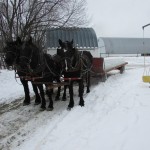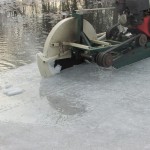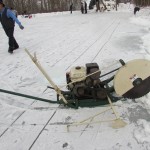
MOUNT VERNON, Ohio — Despite some dictionary definitions of a frolic include a drunken brawl, in an Amish community, it’s more a social event.
The daunting task of cutting and hauling 25 or 30 tons of ice to fill the 12-by-12-by-8 cubic foot interior of a Styrofoam icehouse would tax the resources of an individual family. But when a couple or more families get together with a few horse-drawn wagons that will haul a ton and a half of ice each the short distance from a farm pond to the icehouse, the task becomes a frolic.
Day starts early
A near carnival atmosphere prevailed when a dozen or more intrepid souls braved the subfreezing weather at dawn recently to cut and haul pond ice to a nearby icehouse.
Preparations for ice cutting started a couple of weeks earlier, as soon as the ice on the Dennis Miller farm pond in Knox County was strong enough to support foot traffic to clear snow.
Snow is a great insulator and will prevent heat escaping from the pond and slow thick, crystal clear ice from forming. This year, because of an unusually cold January with weeks of below-freezing temperature, the ice was up to 7 inches thick by the middle of the month.
Farm pond
The primary purpose of the man-made farm pond is fire protection; irrigation, fishing, swimming, skating and other recreational events are a bonus.
Spring fed and graded to divert surface water, it is fenced to keep out cattle and policed against migrating waterfowl; the water shed is lab tested periodically.
Getting started
The first order of business was to mark the area of ice to be cut with parallel lines about 16 inches apart with a circular saw on a sled.
Then, two parallel cuts were cut nearly through the ice at right angles. A chain saw was brought in to cut this strip of ice at the original layout lines, and a man followed with a shovel, breaking the blocks loose for a third man to haul up onto the ice with a straw hook. He pushed them away from the open water to a couple of teen boys, who, in turn, handed them off to youths anxious to prove they could earn their salt easily pushing the near 100-pound blocks of ice over the wet, slick surface to waiting adults and older boys loading the low bed, horse-drawn wagons.
Friendly competition
Everybody was shod with ice cleats and they could really move the blocks on the pond surface. It wasn’t long before heavy coats were shed, as the youth warmed up in the below-freezing cold trying to see who could send a block of ice the further with one shove.
The little guys really got into it, developing their technique for the day when they, too, would be able to send a block of ice skidding from the cutting area to the shore with one shove, and the older boys coached them to develop good form.
Young ladies bringing hot drinks and doughnuts for the working crew were interested in firing cakes of ice across the pond. I don’t know if they got into the act or not, but in past years I have seen some of them do better than hold their own, rapid firing cakes of ice to the shore.
With icy road conditions, this was one of those days when it was wise to have at least three horses hitched, and they were. Pulling a third of the load instead of half allowed them to be a little more confident of the footing.
Ice storage
Some families use refrigerated truck bodies that will keep ice for quite a while, but the preferred icehouse is a two-foot thick wall structure of Styrofoam that keeps ice for up to two years, they tell me.
Sixteen-by-four foot wide blocks of Styrofoam will yield a 12-by-12-by-8 foot storage space that will hold better than 35 tons of ice. But they will probably never pack it that tight, so it’s probably housing closer to 30 tons of ice.
That’s plenty for even a couple of families. And if we have a mild winter with no ice cutting, as we sometimes do, that 30 tons of ice will carry them into the second year.


















Your coverage, Mr. Bolduc, of the ice cutting is appreciated! What a great year for such.